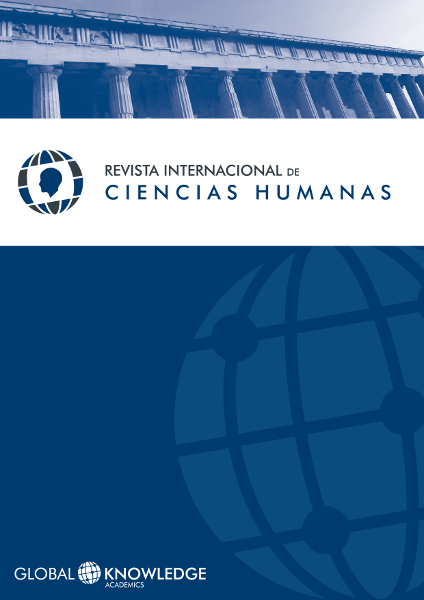A New Approach to the Teaching of Foreign Languages: the Development of Bodily-Kinesthetic Intelligence within the Framework of the Theory of Multiple Intelligences
DOI:
https://doi.org/10.37467/gka-revhuman.v3.718Keywords:
Multiple Intelligences, Language Learning, Motivation, Bodily-Kinesthetic Intelligence, Cognitive DevelopmentAbstract
This paper presents a discussion on the development of body expression as a mean of promoting disinhibition, in other words, the perception of one’s own body where there is other people. Consequently, it will produce motivation and promote creativity. In the foreign language classroom it is possible to get to this stage through the development of games, dance and activities that allow contact with the other. Thus, based on some questions raised by the cognitive development theory to treat the study of processes such as language, perception, memory, reasoning and problem solving and some discussion of the multiple intelligences theory of Gardner (1994), specifically about the bodily- kinesthetic intelligence, it is intended to analyze how the wok with body language can help in the development of a student's abilities and encourage his/her creativity and his/her process of acquisition and learning in the classroom, concretely, the foreign language class. In addition to bodily-kinesthetic intelligence, Gardner proposes that each person has at least eight intelligences or cognitive skills which work together, but as autonomous entities that require interaction. The author assumes that all intelligences are equally important, although each person has an intelligence more developed than another, depending on the cultural setting in which he/she is inserted, which may explain, to some extent, why people learn in different ways, according to their skills. However, although all intelligences are equally important, our school system tends to emphasize logical-mathematical intelligence and linguistic intelligence to the point that, in some cases, deny the existence of the others. Therefore, education should be thought from a point of view which considers the different ways of learning and, in the specific case of the teaching and learning of foreign languages, it is important to adopt a "plural approach to cognition", not an "unilateral" one, different from many authors who have treated human development.
References
Alves, R. (2000). Filosofia da ciência – Introdução ao jogo e a suas regras . São Paulo: Edições Loyola.
Bernstein, N. (1967). The coordination and regulation of movements . London: Pergamon Press.
Campbell, L. (2000). Ensino e aprendizagem por meio das Inteligências Múltiplas . Porto Alegre: Artes Médicas Sul.
Gama, M. C. S. S. A Teoria das Inteligências Múltiplas e suas implicações para Educação. Periódico en internet, 1998, http://www.homemdemello.com.br/psicologia/intelmult.html (Fecha de consulta: mayo de 2010).
Garaudy, R. (1980). Dançar a Vida . Rio de Janeiro: Nova Fronteira.
Gardner, H. (1994). Estruturas da Mente – A Teoria das Inteligências Múltiplas. Porto Alegre: Artes Médicas Sul.
Gardner, H. (2000a). Inteligência – Um conceito reformulado . Rio de Janeiro: Objetiva.
Gardner, H. (2000b). La educación de la mente y el conocimiento de las disciplinas – lo que todo estudiante debería aprender . Barcelona: Paidós.
Gould, S. J. (1999). A falsa medida do Homem . São Paulo: Martins Fontes.
Heinecke Scott, L. (2005). Método de intelección estratégica – relación, creencia, cultura y sociedad . Santiago de Chile: Nexo Impresores.
Hernández, V., Rodríguez, P. (1996). Expresión corporal con adolescentes – Sesiones para tutoría y talleres. Madrid: Editorial CCS.
La Taille, I., Kohl de Oliveria, M., Dantas, H. (1992). Piaget, Vygotsky, Wallon – Teorias psicogenéticas em discussão . São Paulo: Summus.
Pease, A.; Pease, B. (2005). Desvendando os segredos da linguagem corporal. Rio de Janeiro: Sextante.
Piaget, J. (1993). A linguagem e o pensamento da criança. São Paulo: Martins fontes.
Prodócimo, E. A Educação Física escolar e as Inteligências Múltiplas, Revista Digital . Buenos Aires, Año 11, N° 105 (febrero de 2007), http://www.efdeportes.com/efd105/a-educacaofisica-escolar-e-as-inteligencias-multiplas.htm (Fecha de consulta: mayo de 2010).
Romero Martín, R. (1999). “La expresión y comunicación corporal desde el ámbito de la educación física: elementos, características y enfoque globalizador de la misma”. En Linares, D., Zurita, F., Iniesta, J. A. Expresión y comunicación corporal en Educación Física. Granada: Asociación para el desarrollo de la Comunidad Educativa en España y Grupo Editorial Universitario.
Saviani, D. (1982). Educação – do senso comum à consciência filosófica . São Paulo: Cortez Editora: Autores Associados.
Schinca, M. (1988). Expresión corporal: bases para una programación teórico-práctico. Madrid: Editorial Escuela Española.
Schinca, M. (1989). Psicomotricidad, Ritmo y Expresión Corporal. Madrid: Editorial Escuela Española. Vázquez Romero, R. A., Tamayo Fajardo, J. A. “ Utilización de la expresión corporal como medio de enseñanza de los diferentes contenidos del área de educación física en la escuela”. Revista Digital . Buenos Aires, Año 10, N° 77 (octubre de 2004), http://www.efdeportes.com/efd77/exp.htm. (Fecha de consulta: mayo de 2010).
Weil, P., Tompakow, R. (2004). O corpo fala: a linguagem silenciosa da comunicação nãoverbal. Petrópolis: Vozes.
Wosien, M. G. (2004). Dança: símbolos em movimento . Traducción de Bettina Aring Mauro. São Paulo: Anhembi Morumbi.
Downloads
Published
How to Cite
Issue
Section
License
Those authors who publish in this journal accept the following terms:
- Authors will keep the moral right of the work and they will transfer the commercial rights.
- After 1 year from publication, the work shall thereafter be open access online on our website, but will retain copyright.
- In the event that the authors wish to assign an Creative Commons (CC) license, they may request it by writing to publishing@eagora.org









